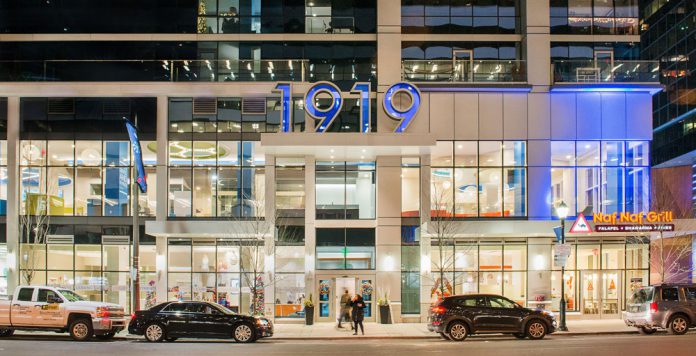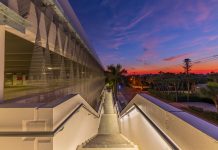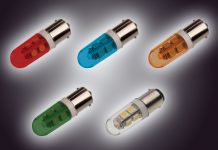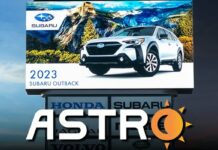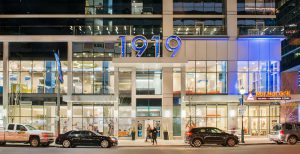 Located in Center City Philadelphia, 1919 Market Street is a mixed-use luxury apartment building with a wealth of amenities and fantastic skyline views. The building wanted signage that reflected the luxury living it offered, and so the general contractor Hunter Roberts brought Nova Sign Group from Mount Holly, New Jersey onto the project.
Located in Center City Philadelphia, 1919 Market Street is a mixed-use luxury apartment building with a wealth of amenities and fantastic skyline views. The building wanted signage that reflected the luxury living it offered, and so the general contractor Hunter Roberts brought Nova Sign Group from Mount Holly, New Jersey onto the project.
(Note: We covered another of Nova Sign Group’s projects in our March 2018 issue, “The Sign-Making Jackpot.”)
Nova Sign Group joined developers LCOR & Brandywine Realty Trust as well as designers Poulin+ Morris on the project. The plans were about 90 percent complete for the signage package, but the design ideas were still pretty abstract.
“They came to us with a lot of conceptual ideas, not necessarily engineered ideas, kind of an idea board,” says Corey Kennedy, COO of Nova Sign Group. “We took their idea board and went and visited several locations throughout the area, which were their basis of design.”
From there, the sign company drew up the final designs using a variety of software, including Adobe Illustrator, AutoDesk® Inventor®, SOLIDWORKS, as well as some other CAD programs.
The project called for a variety of exterior and interior signage.
For the exterior, Nova Sign Group fabricated and installed a large set of channel letters spelling out 1919 and a unique water-jetted granite inlay in the front of the building. In the parking garage, the sign company supplied the channel letters, flag signs, and wayfinding signage.
On all the interior floors, the sign company supplied the apartment identification signs outside of the doorways, common area signage, lighted safety signage, and the ADA/wayfinding signage.
Interior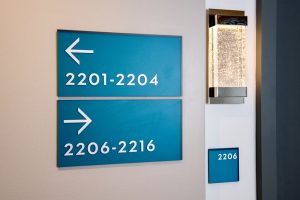
Nova Sign Group was tasked with supplying over 1,500 signs for the interior of the building, and all of them were created using thermoforming.
First Nova Sign Group created a CNC-routed negative out of extruded acrylic using their five-by-ten MultiCam APEX3R CNC router. The shop then heated up a piece of acrylic to 350 degrees in a press for about five minutes. They exerted 5000-psi force down on the piece of acrylic and pushed it into the negative. The result was a solid piece of acrylic where the beads of Braille and the letters could not be picked off.
Following the thermoforming process, colors were painted onto the acrylic subsurface using both Benjamin Moore and Sherwin Williams paints.
The interior signs were installed in the apartment building using 3M VHB™ tape and silicone.
Channel Letters
On the exterior of 1919 Market Street, Nova Sign Group was tasked with creating a set of channel letters spelling out “1919,” which were installed over the top of the main building entrance.
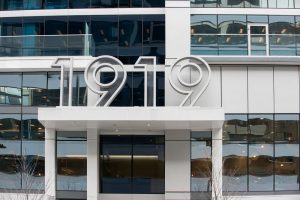 The challenge with this set of letters was providing structural support while still meeting design requirements. “They didn’t want any kickers or any supports back on that so basically we had to rely on doing more or less a butt weld to a bottom plate on there,” says Kennedy. “We had to think up how we were going to engineer this structure to basically hold a butt-welded piece of a letter directly from the bottom with no visible structure.”
The challenge with this set of letters was providing structural support while still meeting design requirements. “They didn’t want any kickers or any supports back on that so basically we had to rely on doing more or less a butt weld to a bottom plate on there,” says Kennedy. “We had to think up how we were going to engineer this structure to basically hold a butt-welded piece of a letter directly from the bottom with no visible structure.”
The solution was to waterjet the face and the back of the letters out of 1/2-inch plate aluminum. The returns were hand-formed out of .063 aluminum.
Both the back, front, and returns of the letters were painted with Matthews Paint in Brushed Aluminum. In the center of the letters, the shop used 1/2-inch-thick clear polycarbonate.
The letters were held together with countersunk screws in the returns, and Bitro LEDs were embedded in the returns so that they shined in on the inside of the letter and illuminated the polycarbonate from the edge.
The letters were then butt-welded to one-inch solid plate on the bottom. A raceway fabricated from 3/16-inch-thick aluminum housed the power supplies and secondary wiring, and it was painted with Matthews Paint in Brushed Aluminum to match the letters.
For the installation, the 1919 letters (which were already welded to the plate) were taken to the job site on a flatbed trailer and lifted in one piece using the shop’s fifty-foot Elliott Equipment truck. The letters and raceway were attached to the existing structure using Hollo-Bolts.
“What we ended up having to do is cut the roof away in certain locations and install stubs through the roof to accommodate our plate aluminum,” says Kennedy. “Then have the roofer come back after, flash over the top of the entire thing, close it back up, and accomplish what we needed to be done while still maintaining the warranty of the roof.”
Nova Sign Group had to install the sign off-hours and worked from 10 pm through 7 am. “We had to basically close off one of the lanes of the road and ensure that none of the residents of the building were going to be coming in and out through that front door because this is right over their main and pretty much only entrance into the building,” explains Kennedy.
Parking Garage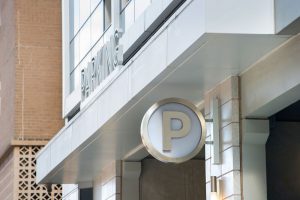
The parking garage required a variety of signage, including letters spelling out “Parking” at the entrance.
These letters were fabricated in the same way as the 1919 letters over the main entrance with a combination of aluminum fronts and backs and clear polycarbonate in the center of the letters. Bitro LEDs were also used to illuminate these letters.
(Note: All the exterior signs are lit with RGB LEDs, and they are synced up to one controller that can create effects like changing colors or fading in and out.)
Nova Sign Group also fabricated a three-foot-diameter, round flag sign with a “P” in it. The circular sign was made from aluminum and the “P” is stainless steel.
A whiteout backing made from white acrylic was sandwiched between two clear pieces of polycarbonate so that the sign was evenly lit by Bitro LEDs.
Nova Sign Group used its fifty-foot Elliott Equipment truck to install these two parking garage signs. The installation had to be completed off hours again and required the street to be shut down.
The interior wayfinding and level identification parking garage signage, such as “P4” and “P5,” were plastic letters CNC-cut on the shop’s MultiCam router. They were then 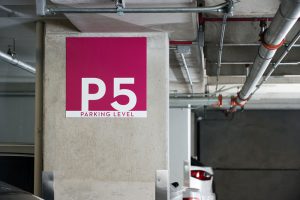 painted with AkzoNobel paints and installed on the walls or columns of the garage.
painted with AkzoNobel paints and installed on the walls or columns of the garage.
Hanging signs were also provided, and they were fabricated from .080 painted aluminum.
Reflective direct-UV prints were printed onto 3M reflective vinyl using the shop’s Mimaki four-by-eight flatbed UV printer and then applied to the aluminum.
Inlay
One of the final elements of this large signage job is a unique inlay at the main entrance, and it required Nova Sign Group to design it twice.
Originally it was a glass inlay with stainless steel letters that was backlit with Bitro LEDs. “We unveiled it for about twenty-four hours, and they got a snowstorm, and it was a little more slippery than intended,” says Kennedy. “So they had us cover it back up.”
After two months of re-engineering the inlay, Nova Sign Group decided to use granite on the redesign. They partnered with a stone manufacturer and used two different types of granite to create the inlay.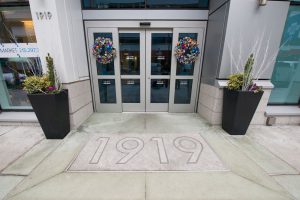
The 1919 was waterjet-cut out of a solid white piece of granite, and then a darker granite was used in the cut lines.
The glass inlay was removed, and the four-by-eight, roughly 600-pound granite inlay was brought to the site in one piece.
“We carried it into place with two straps. Beneath it there’s sand under there to absorb the impact and to level it out,” says Kennedy. “We carefully lowered it into place and then removed the straps. We filled the gap that’s around the outside with a silicone mastic.”
By Ashley Bray
All Photos: Julia Lehman


